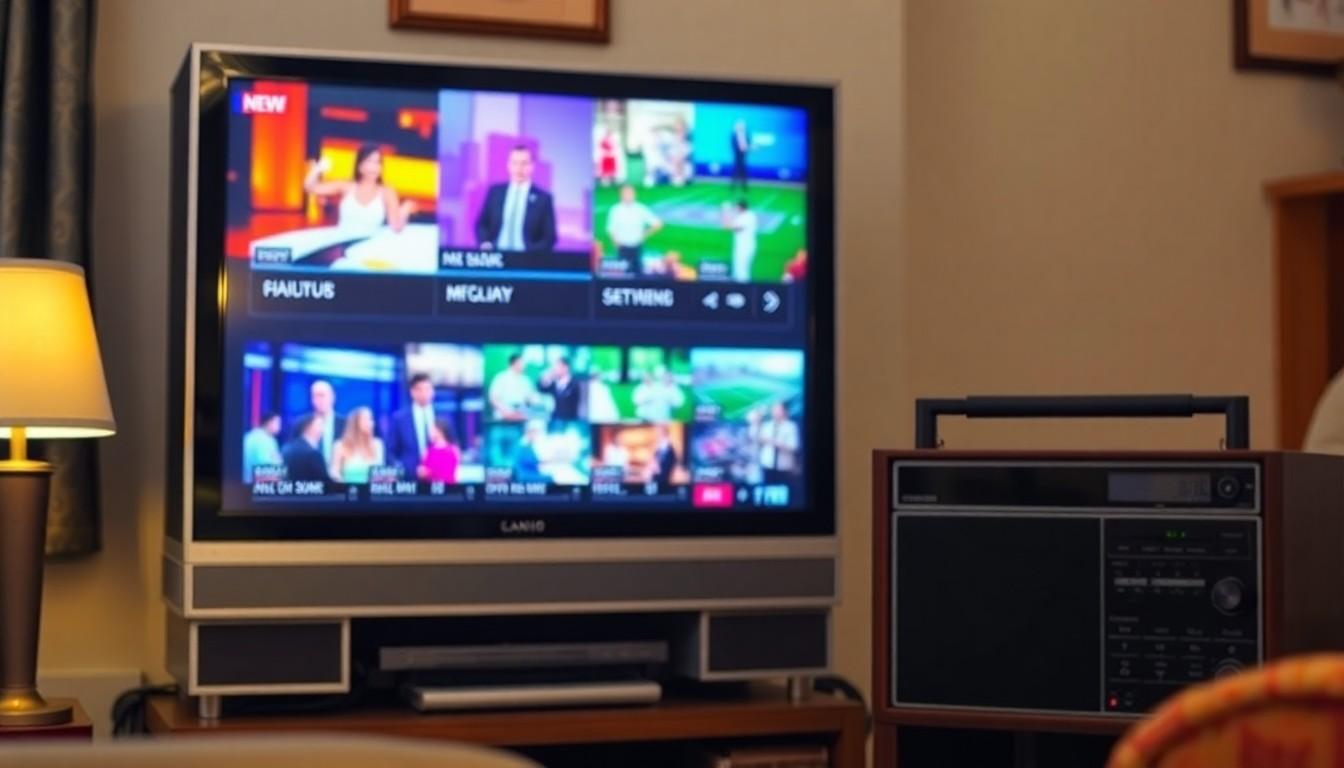In a world where cat videos reign supreme and breaking news can be delivered in a tweet, broadcast media stands tall as a timeless titan of information. It’s the trusty steed of communication, galloping into homes with the latest updates, entertainment, and everything in between. From the crackle of a radio to the vibrant glow of a television screen, broadcast media connects people to the pulse of the world.
What Is Broadcast Media
Broadcast media encompasses the distribution of audio and visual content to a wide audience. This includes platforms like television and radio, which deliver programming across various formats. Such media serves as a vital source of news and entertainment, effectively reaching millions of viewers and listeners.
Television broadcasts cover a range of genres, including news, sports, drama, and documentaries. Millions tune in daily to stay informed about current events, local news, and international affairs. Radio stations offer similar programming, including talk shows, music, and news segments, catering to diverse listener preferences.
Significant technological advancements have expanded broadcast media capabilities. Digital broadcasting has increased the number of channels available, allowing for niche programming that targets specific audiences. High-definition and satellite broadcasting enhance the quality of content delivered, improving viewer experiences.
Moreover, live broadcasts enable real-time engagement with audiences. Events such as sports games, concerts, and news coverage bring people together, fostering a sense of community despite physical distances. Public broadcasting services often emphasize educational programming, ensuring access to content that informs and inspires.
Credibility remains a cornerstone of broadcast media. Established networks adhere to journalistic standards, striving to provide accurate and fair reporting. This commitment to integrity helps maintain public trust and ensures that audiences rely on these sources for their information.
Broadcast media plays a crucial role in shaping public perception and providing access to information. It remains an essential part of modern communication, adapting to meet the evolving needs of society while maintaining its foundational purpose of connecting people.
Types Of Broadcast Media

Broadcast media primarily includes television and radio, important staples that engage audiences through varied content formats.
Television
Television stands as a dominant form of broadcast media, reaching millions worldwide. It provides diverse programming, including news, sports, dramas, and documentaries. Many households rely on television for news updates, making it crucial for informing the public. High-definition broadcasts enhance viewing experiences by providing clearer images and sound. Cable and satellite services add depth with multiple channels and specialized content. Live events draw significant viewership, connecting communities during major occurrences. Channels like CNN, BBC, and ESPN exemplify reliability and diversity in broadcast television.
Radio
Radio serves as another vital component of broadcast media, offering audio content via AM and FM frequencies. It caters to various preferences, featuring talk shows, music, and news segments. Many listeners appreciate its accessibility, as radio can be enjoyed during commutes or while multitasking. Local stations provide community-centric content, fostering regional connections. Digital streaming has broadened listening options, allowing access to shows and podcasts anywhere. Popular networks like NPR and BBC Radio illustrate how radio continues to adapt, maintaining relevance in an evolving media landscape.
History Of Broadcast Media
Broadcast media has evolved significantly since its inception in the early 20th century. The development of radio broadcasting in the 1920s marks a pivotal moment, allowing audio content to reach vast audiences. Regular transmissions soon followed, with major networks like NBC and CBS emerging shortly thereafter.
Television technology evolved during the 1930s, leading to the first public broadcasts in the late 1930s. World War II played a crucial role in boosting television’s popularity, as news coverage brought real-time updates into living rooms. The post-war era saw rapid expansion in both radio and television, with household ownership of televisions rising dramatically.
The introduction of color television in the 1950s revolutionized viewer experiences. Major events, such as the moon landing in 1969, showcased the power of broadcast media to connect audiences with history as it unfolded. Attention to public broadcasting increased during this period, with organizations like PBS focusing on educational content.
Technological advancements continued through the late 20th century. Satellite and cable television emerged, offering diverse channels and programming options. Viewers gained access to niche content that catered to specific interests, which transformed the media landscape.
The rise of the internet in the 1990s introduced new challenges and opportunities. Streaming services disrupted traditional broadcast models, allowing audiences to consume content on-demand. Despite these changes, established networks maintained credibility and trust through journalistic standards.
Digital broadcasting emerged in the early 21st century, enhancing audio and visual quality. High-definition broadcasts became standard, engaging viewers with clearer images and richer sound. Today, broadcast media still plays a vital role in informing and connecting individuals worldwide, adapting to technological advancements while retaining its foundational purpose.
The Role Of Broadcast Media In Society
Broadcast media significantly influences society through its various functions. It serves as the primary vehicle for delivering information and entertainment to audiences around the world.
Information Dissemination
Information dissemination occurs at an unprecedented scale via broadcast media. Television channels and radio stations provide access to news updates, educational content, and emergency alerts. These platforms keep communities informed about local and global events, ensuring people receive reliable information swiftly. Established networks adhere to strict journalistic standards, enhancing credibility and trust. Live broadcasts allow for real-time updates during critical situations, fostering public awareness. For example, during natural disasters, broadcasters relay crucial information regarding safety and evacuations, which saves lives.
Entertainment
Entertainment forms a core pillar of broadcast media’s role in society. Television programs span diverse genres, including dramas, comedies, reality shows, and documentaries. People engage with these offerings during their leisure time, thus reinforcing social connections and shared experiences. Radio, too, plays an essential role, featuring music, audio dramas, and talk shows tailored to various tastes. Broadcast media’s ability to adapt to audience preferences enhances its appeal. For instance, special events like award shows draw significant viewership, creating shared moments among audiences.
Cultural Impact
Broadcast media shapes cultural narratives and fosters dialogue within society. It introduces audiences to different perspectives, showcasing diverse cultures and lifestyles. Through documentaries and cultural programming, viewers gain insight into global issues and historical contexts. The reach of multinational networks amplifies the distribution of these narratives, promoting understanding and empathy. Furthermore, local stations highlight regional customs and stories, enriching community identity. Events like the Super Bowl or major award shows not only entertain but also become cultural phenomena, reflecting societal values and conversations.
Technological Advancements In Broadcast Media
Digital broadcasting revolutionizes how audio and visual content reaches audiences. Transitioning from analog to digital formats enhances clarity and extends programming options. With the advent of high-definition technology, viewers experience sharper images and superior sound quality. Streaming services further transform broadcast media by allowing on-demand access to a vast array of content.
Satellite television expanded the reach of broadcast media, delivering channels to remote locations previously underserved. Cable networks proliferated, offering specialized content across genres, catering to diverse viewer interests. Innovations like cloud-based broadcasting enable content creators to distribute programs efficiently.
Mobile technology plays a significant role in the accessibility of broadcast media. Viewers can now stream live content directly on smartphones and tablets, providing flexibility in how they consume media. When users connect through apps, they engage with audiences in real time, enhancing entertainment experiences.
Social media integrations create opportunities for broadcast networks to interact with viewers. Platforms like Twitter and Facebook facilitate real-time discussions around programming, strengthening community engagement. Enhanced analytics help networks tailor content to audience preferences, driving higher viewer satisfaction.
Augmented reality and virtual reality are emerging technologies that promise to elevate broadcast experiences. These innovations allow for immersive storytelling, drawing audiences deeper into programming. As media consumption evolves, adapting to technological advancements remains crucial for the industry.
Broadcast media continues to be a cornerstone of information and entertainment in today’s fast-paced world. Its ability to reach vast audiences through television and radio ensures that essential news and cultural narratives are accessible to everyone. As technology evolves, broadcast media adapts while maintaining its commitment to credibility and public trust. The integration of digital advancements enhances viewer experiences and keeps communities connected. By fostering engagement and promoting understanding, broadcast media remains an indispensable tool for shaping public perception and enriching lives across the globe.
